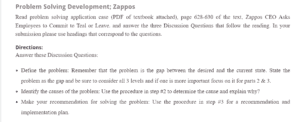Problem-Solving Development
A problem is a challenging situation regarded as undesirable and must be dealt with and trounced. The practice of solving problems at workplaces can be difficult. With different approaches, it is usually easier for people in the same organization to use other problem-solving techniques to solve a specified problem.
Are you seeking an original “Problem Solving Development case study” copy? Contact us
Define the problem: Remember that the problem is the gap between the desired and the current state. State the problem as the gap and consider all three levels; if one is more important, focus on it for parts 2 & 3.
The Three Stages Explained
Understanding the Problem: The essential part of finding a solution to a problem is understanding the issue at hand. At Zappos, excellent customer service should be provided, which is a key contributor to the company’s success. The superior customer services enhance consumer satisfaction and loyalty to Zappos.
Strategizing: After understanding the problem, one should choose an effective strategy aimed at strategizing to solve the problem. Zappos has a workplace that functions like a family where every stakeholder is happy and works together as a team; fun is also an integral element in the organization, both in and out of office activities (Riane, 2014).
Implementing problem-solving approaches: Identified problem-solving techniques should be implemented in checking out the reasoning and reputation of the company. Building a strong team with good interpersonal relationships, high commitment levels for the members, and a desire to achieve common goals is the key to accomplishing group goals and the entire organization’s objectives (Raver, 2015).
Source (Riane, 2014)
Identify the causes of the problem: Use the procedure in step #2 to determine the cause and explain why?
I think the unique culture of Zappos will help the company in the long run since this model revolves around growing long-term relations with customers. Zappos attempts to revolutionize how business is conducted by ensuring it has the leading company customs where having a family atmosphere is part of it. They aim to build a company where people like to work and customers like doing business. Tony Hsieh, the CEO, says that they desire to give the best customer assistance and experience. Each employee takes part in a four-week course, from the administration down, regardless of whether their job involves talking with customers. They see to it that those employed are passionate about the company and want to be there by offering employees money for them to leave. The company regards and honors everyone’s uniqueness and motivates people to desire to learn and grow (Raver, 2015). While distributing a wide variety of shoes, Zappos branched into clothes, electronics, and cookware and planned on enlarging even more. An example of how they think they get customer loyalty is by directing them to a competitor’s website if needed is no longer in stock.
Make your recommendation for solving the problem: Use the procedure in step #3 for a recommendation and implementation plan.
I think companies in the future will follow this model because a unique company culture assures you of dedicated employees, excellent performance, and the capability of inviting the best talent. These make the customers, employees, and investors happy, ultimately maximizing yields, innovation, and functional efficiency (Warrick, 2016). The company emphasizes upholding this culture which brings all the team members together to form one big family. Developing a friendly, warm, and exciting environment is the key to a motivated team that looks forward to giving the best. Informal interactive activities, often done outside the usual office or workplace setting, are essential and active contributors to team building.
Other Related Post: Resilience Mastery Reflection
References
C. Chadwick and J. L. Raver, “Motivating Organizations to Learn: Goal Orientation and Its Influence on Organizational Learning,” Journal of Management, March 2015, 957– 986
Riane, F., Artiba, A., & Elmaghraby, S. E. (2014). A hybrid three-stage flow shop problem: Efficient heuristics to minimize makespan. European Journal of Operational Research, 109(2), 321-329.
Warrick, D. D., John F. Milliman, and Jeffery M. Ferguson. “Lessons learned from Zappos on what it takes to build high-performance cultures.” Organ Dyn (2016):13-24.
ORDER A PLAGIARISM-FREE PAPER HERE
We’ll write everything from scratch
Question
Problem-Solving Development; Zappos
Read problem-solving application case (PDF of textbook attached), pages 628-630 of the text, Zappos CEO Asks Employees to Commit to Teal or Leave. And answer the three Discussion Questions that follow the reading. In your submission, please use headings that correspond to the questions.

Problem-Solving Development
Directions:
Answer these Discussion Questions:
- Define the problem: Remember that the problem is the gap between the desired and the current state. State the problem as the gap and consider all three levels; if one is more important, focus on it for parts 2 & 3.
- Identify the causes of the problem: Use the procedure in step #2 to determine the cause and explain why?
- Make your recommendation for solving the problem: Use the procedure in step #3 for a recommendation and implementation plan.
Provide a title page with your name and date.
Your content should include 600 words and use a double-spaced Times New Roman font.
You should include headings, topic sentences, and the inclusion of weekly learning.
You can complete this assignment using the text material; however, if you use an outside source, please cite it using APA format.
Please review the rubric for my expectations and completely answer all the questions.
Organizational_Behavior_A_Practical,_Problem-Solving_Approach,_2nd_Edition.pdf_-_Google_Drive (1)

